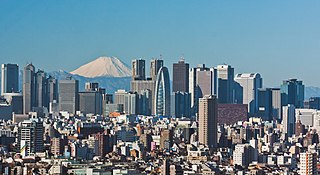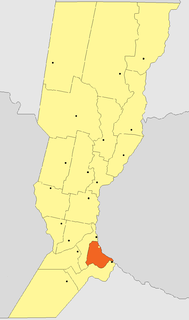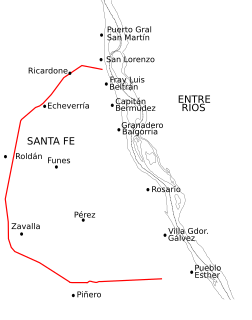| Greater Rosario Towns and cities |
|---|
 Capitán Bermúdez is a city in the province of Santa Fe, Argentina, located within the metropolitan area of Greater Rosario,, on the western shore of the Paraná River. It had a population of about 29,000 inhabitants at the time of the 2010 census [INDEC].  Fray Luis Beltrán is a small city in the province of Santa Fe, Argentina, located within the metropolitan area of Greater Rosario, north of the city of Rosario, on the western shore of the Paraná River. It had a population of about 15,000 inhabitants at the 2010 census [INDEC].  Funes is a small city in the province of Santa Fe, Argentina, located within the metropolitan area of Greater Rosario, about 15 km west from downtown Rosario. It has a population of about 23,500 inhabitants. |
 |
Greater Rosario is the metropolitan area of the city of Rosario, in the province of Santa Fe, Argentina. This metropolis has a population of about 1.3 million (1,276,000 million inhabitants) [1] thus being Argentina's third most populated urban settlement, after Buenos Aires and Córdoba. [2]

A metropolitan area is a region consisting of a densely populated urban core and its less-populated surrounding territories, sharing industry, infrastructure, and housing. A metro area usually comprises multiple jurisdictions and municipalities: neighborhoods, townships, boroughs, cities, towns, exurbs, suburbs, counties, districts, states, and even nations like the eurodistricts. As social, economic and political institutions have changed, metropolitan areas have become key economic and political regions.

Rosario is the largest city in the central Argentina province of Santa Fe. The city is located 300 km (186 mi) northwest of Buenos Aires, on the west bank of the Paraná River. Rosario is the third most populous city in the country, and is also the most populous city in Argentina that is not a provincial capital. With a growing and important metropolitan area, Greater Rosario has an estimated population of 1,276,000 as of 2012. One of its main attractions includes the neoclassical architecture that has been retained over the centuries in hundreds of residences, houses and public buildings.

Argentina is subdivided into twenty-three provinces and one autonomous city, Buenos Aires, which is the federal capital of the nation as decided by Congress. The provinces and the capital have their own constitutions, but exist under a federal system.
Contents
The Greater Rosario comprises Rosario itself (population about 910,000) and a large area around it, spreading in all directions except eastward (because of the Paraná River). Directly to the south it includes the city of Villa Gobernador Gálvez, with a population of about 75,000, at about 10 km (6.2 mi) from the center of Rosario.

The Paraná River is a river in south Central South America, running through Brazil, Paraguay, and Argentina for some 4,880 kilometres (3,030 mi). It is second in length only to the Amazon River among South American rivers. The name Paraná is an abbreviation of the phrase "para rehe onáva", which comes from the Tupi language and means "like the sea". It merges first with the Paraguay River and then farther downstream with the Uruguay River to form the Río de la Plata and empties into the Atlantic Ocean.

Villa Gobernador Gálvez is a city in the province of Santa Fe, Argentina, located on the western ravine of the Paraná River, within the metropolitan area of Greater Rosario. It has 74,509 inhabitants per the 2001 census [INDEC]. It is separated from Rosario, to the north, by the Saladillo Stream. It is the fourth most populated city in the province and the second in the metropolitan area.
To the west and south-west there are several smaller towns and cities (Funes, Roldán, Pérez, Soldini); Roldán is 23 km from Rosario's center. These settlements were incorporated into the metropolis due to their vicinity to major roads leading into Rosario, and many people living there habitually commute to Rosario.
Roldán is a small city in the province of Santa Fe, Argentina, located within the metropolitan area of Greater Rosario. According to the 2001 census, it had a population of 11,470 inhabitants. Its area is 114 km².

Pérez is a city in the province of Santa Fe, Argentina. It is part of the Greater Rosario metropolitan area, and lies 175 km south of the provincial capital. It has a population of about 26,000 inhabitants.

Soldini is a town (comuna) in the province of Santa Fe, Argentina. It is part of the Greater Rosario metropolitan area, and lies 127 km south from the provincial capital. It has a population of about 2,800 inhabitants.
The farthest end is to the north, following the coast of the river; from Rosario one finds, in succession and usually merging into each other, the towns of Granadero Baigorria, Capitán Bermúdez, Fray Luis Beltrán, San Lorenzo (already in a different departamento , with a population of over 40,000), and Puerto General San Martín, the last being at a distance of 35 km from Rosario.

Granadero Baigorria is a city in the south of the province of Santa Fe, Argentina, located directly north of Rosario, on the western shore of the Paraná River, and forming part of the Greater Rosario metropolitan area. Its population is about 43,000 inhabitants (2015).

San Lorenzo is a city in the south of the province of Santa Fe, Argentina, located 23 km north of Rosario, on the western shore of the Paraná River, and forming one end of the Greater Rosario metropolitan area. It is the head town of the San Lorenzo Department, and it has about 46,000 inhabitants according to the 2010 census [INDEC].

Departments form the second level of administrative division, and are subdivided in municipalities. They are extended in all of Argentina except for the Province of Buenos Aires and the Autonomous City of Buenos Aires, the national capital, each of which has different administrative arrangements.
The north of the Greater Rosario is one end of an area traditionally called Cordón Industrial ("Industrial Corridor"), since it was traditionally a heavily industrialized productive region. The prelude to the economic crisis in the 1990s largely dismantled the industrial infrastructure and damaged agricultural exports. As of 2006 the recovery of national economy has revitalized them, but high levels of poverty and unemployment persist (the last official survey indicates that 27.4% of the population is under the poverty line). [3]
The 1998–2002 Argentine Great Depression was an economic depression in Argentina, which began in the third quarter of 1998 and lasted until the second quarter of 2002. It followed the 1974–1990 Great Depression after a brief period of rapid economic growth.
Events in the year 2006 in Argentina.











